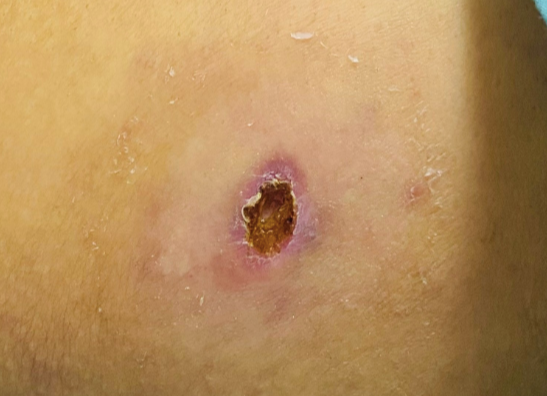Phu Tho General Hospital said it had just admitted a 73-year-old female patient from Vinh Phuc who had a fever for more than a week without improvement. Previously, the patient had gone to a medical facility near her home for examination and treatment for 5 days but the fever did not go away.
At the time of admission, the patient had a fever of over 39 degrees Celsius. After examination, the doctor discovered that the patient had an oval spot with a red border in the middle and black scabs in the armpit. This is a typical lesion of scrub typhus .

Image of patient's injuries upon admission
The patient was prescribed antibiotics according to the treatment regimen for scrub typhus. On the third day after hospitalization, the patient's fever was completely gone, his health was stable, and he was discharged after a week of treatment.
A few days ago, the Yen Bai Provincial Department of Health announced that in August, the locality recorded a death due to scrub typhus. The patient was a 16-year-old female patient from Tram Tau District ( Yen Bai ). The cause of death was determined to be that the patient came to the hospital late for examination and treatment. When arriving at the hospital, the symptoms were very severe, the disease progressed rapidly, accompanied by complications such as septic shock, blood clotting disorders, and gastrointestinal bleeding. The prognosis upon admission was very poor, the patient died after one day of treatment.
The Yen Bai Provincial Department of Health said that since the beginning of the year, the locality has recorded 290 cases of scrub typhus. In August alone, the province recorded 106 cases, an increase of 57 cases compared to the same period in 2022 and an increase of 12 cases compared to July.

Ulcers on a patient with scrub typhus. Photo: Yen Bai Provincial Department of Health
Scrub typhus is a disease caused by the bacteria Orientalis tsutsugamushi transmitted to humans when bitten by mite larvae. The source of infection is wild animals such as rodents (mainly rats), rabbits, birds, or livestock (dogs, pigs, chickens)... The disease occurs year-round but mainly in the rainy season from April-May to September-October, the peak of the disease is in June-September.
This bacteria usually lives in bushes, moist grass above the canopy of tall trees; or in caves where rodents live. All ages can be infected but the disease is mainly distributed in working age.
The bites are usually in soft, moist areas of skin, such as the genitals, anus, groin, armpits, neck, etc., and sometimes in the earlobes, navel, or eyelids.
The disease progresses from mild to severe and can cause complications such as pneumonia, meningitis, myocarditis... or multiple organ failure, leading to death if not detected and treated promptly.
Source


































































































Comment (0)